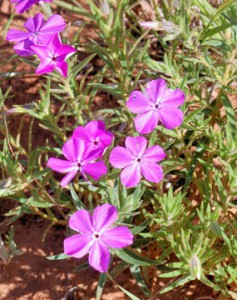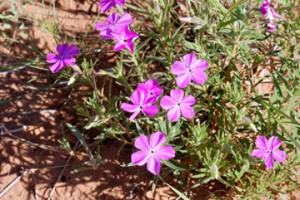Scientific Name: Phlox nana
Plant Family: Polemoniaceae – Phlox
Common Name: Santa Fe phlox
Photos and Text by Janice Tucker
It is always gratifying to find a native plant that grows well in a natural setting and is equally desirable in the home garden. Santa Fe phlox (Phlox nana) is just such a plant, and is on the plant collection list for the new Santa Fe Botanical Garden at Museum Hill.
“Though difficult to propagate and sometimes hard to find in the trade, Santa Fe phlox is worth the effort to locate,” declares Tracy Neal, Santa Fe landscape architect and volunteer consultant to the Santa Fe Botanical Garden.
Santa Fe phlox is a low-growing perennial that reaches a maximum height of only one foot. Stems branch out loosely from a deep taproot, which helps to insure its survival during hot, dry spells. Throughout the summer, Santa Fe phlox blooms continually, producing five-petaled flowers borne on the end of stems covered with narrow, gray-green hairy, sticky leaves.

Phlox nana – Santa Fe phlox. Note leaves
The flowers often have a white-ringed center and come in colors ranging from purple to pink. Although rare, the plant can produce white or yellow flowers.
Santa Fe phlox naturally thrives in canyons, on rocky slopes, along roadsides and in disturbed areas. Bright flowers, small stature, and the ability to mix well with other cultivated plants make Santa Fe phlox a beautiful addition to the home garden. It is happy in the dry Santa Fe climate and adapts well to native soils. Once established, Santa Fe phlox requires little supplemental water.
Natural propagation occurs when fertile seeds ripe for germination “explode” from the seedpod. Therefore, it is an exercise in futility to attempt to collect seeds in order to sow them in an established garden. Serendipity would surely play a role by being present (or not present) at the precise time a seed popped out of the seedpod. Santa Fe phlox can also spread by rhizomes that branch from the taproot but these underground stems grow very slowly, which is why seed propagation is important to the survival of the species. Propagation from root cuttings is possible but not always successful.

Phlox nana – Santa Fe phlox
Phlox is Greek for “flame” or “blaze.” Flame flower is a common name for several species of the Phlox genus. The species, nana, means “dwarf” indicative of the Phlox nana’s small size.
Spanish New Mexicans called the plant Rosita morada. They used it as a treatment for fever blisters by grinding the dry petals into a powder to place on sores. A purplish-red dye was made from steeping the entire plant in tepid water, but results were often disappointing. Therefore, this plant was used only when more reliable plants normally used for dyes were not available.
Tracy Neal expressed the hope that an increased demand for the Santa Fe phlox will spur more growers to figure out how to propagate and grow it in a nursery container. We hope so too. As he says, “The Santa Fe phlox is worth the effort.”


